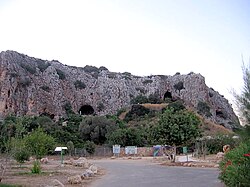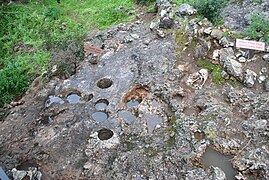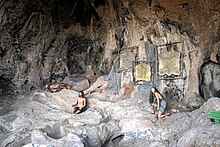Nahal Me'arot
| Sites of human evolution in the Carmel Mountains | |
|---|---|
|
UNESCO world heritage |
|

|
|
| Nahal Me'arot caves, from left to right: El-Wad, Jamal (largest opening in the middle) and Tabun caves (second cave from the right) |
|
| National territory: |
|
| Type: | Culture |
| Criteria : | iii, v |
| Surface: | 54 ha |
| Buffer zone: | 370 ha |
| Reference No .: | 1393 |
| UNESCO region : | Europe and North America |
| History of enrollment | |
| Enrollment: | 2012 (session 36) |
Nahal Me'arot or Nachal Me'arot ( Hebrew נחל מערות, Arabic Wadi el-Mughara ) is a nature reserve on the western slope of the Carmel Mountains in northern Israel . The caves of Nahal Me'arot in Wadi el-Mughara were included in the UNESCO World Heritage List in 2012 under the name Places of human evolution on Mount Carmel: Nachal Me'arot / Caves in Wadi el-Mughara .
These include the Tabun Cave as an important site for finding bones and tools of the Neanderthals , as well as the Skhul Cave, the El Wad Cave and the Jamal Cave as the sites of modern man ( Homo sapiens ) of the Acheuleans - and Moustérien - Culture. What is special about these prehistoric sites is that they were settled for over 500,000 years and - according to current knowledge - Homo neanderthalensis and Homo sapiens lived in these caves in the Carmel Mountains at the same time about 100,000 years ago.
location
The Nahal Me'arot nature reserve is located immediately east of the main road 4 ( Tel Aviv - Haifa ) on both sides of the Wadi Me'arot. The wadi begins near the Druze village of Dalyt al-Karmil and runs west to the Mediterranean coast south of Kibbutz Neveh Yam.
Archaeological exploration
In 1927 the first archaeological excavations of the prehistoric caves began by a British expedition led by Dorothy Garrod . The Tabun Cave was excavated first by archaeologists from the United States and then by Haifa University in the late 1960s .
Tabun Cave
The finds in the Tabun Cave ( German oven cave ) reveal remains of settlements over 500,000 years in several layers about 25 m thick. These can be assigned to different cultures: Acheuléen (500,000 to 400,000 years ago, Homo erectus , hunters and gatherers), Acheuléen-Jabrudien (400,000 to 250,000 years ago) and Moustérien (250,000 to 50,000 years ago, Neanderthals, Homo neanderthalensis ). What is significant for the evolution of mankind is that skeletons that can be assigned to the Neanderthals were found in the Tabun Cave, while skeletons in the neighboring Skhul (Gdi) cave that can be assigned to about the same period, the early anatomically modern ones Represent humans ( Homo sapiens ).
Skhul (Gdi) cave
In the Skhul cave ( German cave of the child ) skeletal remains of early anatomically modern humans ( Homo sapiens ) from the Moustérien culture from about 100,000 years ago were found. These finds were considered to be the earliest of Homo sapiens outside of Africa, where their evolution began about 200,000 years earlier. More recent finds in the Misliya Cave 7 km north of the Skhul Cave, however, provided evidence that Homo sapiens could have settled in the Levant as early as 60,000 years earlier, namely 177,000 to 194,000 years ago .
El Wad Cave
Skeleton from El Wad Cave (on display in the Rockefeller Museum in Jerusalem )
The El-Wad Cave ( German river cave ) is 90 m long and is the longest of the Nahal Me'arot caves. Settlement began here in the period of the Moustérian culture. But most of the finds in this cave are assigned to the Aurignacian culture (40,000 to 20,000 years ago). No traces of settlement were found from the following 8,000 year period, but again in the more recent period of the Natufian culture (12,000 to 9,000 years ago). It is noteworthy for this more recent period that a village settlement structure emerged here for the first time. H. Traces of settlement outside the cave, on the so-called terrace, were found with grave sites, depressions in the rock that could speak for ritual ceremonies, and works of art such as an animal head made of bones. Today's visitor is audiovisually illustrated the life of the archaic Homo sapiens in the El Wad Cave .
Jamal (Gamal) cave
The finds (e.g. hunting equipment) in the Jamal cave ( German camel cave ) are, similar to those in the Tabun cave, attributed to a settlement in the period of the Acheuléen-Jabrudien and Moustérien cultures. In this cave today's visitor is vividly illustrated the way of life in the Moustérien culture.
Significance for human evolution
The human settlement of over 500,000 years in the caves of Carmel allows an insight into the diversity and evolution of man.

The simultaneity of anatomically different hominids , the Neanderthal and the anatomically modern human being, in the same place is of great importance for human evolution. The caves of the Carmel Mountains are the southernmost known occurrences of the Neanderthals (who immigrated from the north) and the northernmost known sites of the early anatomically modern man (who immigrated from the south, from Africa ) in the period 80,000 to 120,000 years ago. The Middle East with the Carmel Caves thus represents one - and according to today's knowledge the only - region of the coexistence of Neanderthals and modern humans. This coexistence had consequences for the evolution of modern humans: DNA analyzes have shown that 1 to 4% of the DNA of Europeans and Asians (subjects of French, Chinese and Papuan descent) matches the DNA of Neanderthals.
The finds show the cultural transition from the hunter-gatherer way of life to agriculture and livestock farming.
See also :
- Human spread # Encounter with other species of the genus Homo
- Gene flow from archaic humans to Homo sapiens
hike
Nahal Me'arot is part of the Israel National Trail , one of the longest and toughest long-distance hiking trails in the world.
Web links
- Entry on the UNESCO World Heritage Center website ( English and French ).
- UNESCO: Sites of Human Evolution at Mount Carmel: The Nahal Me'arot / Wadi el-Mughara Caves.
- Nahal Me'arot prehistoric caves World Heritage Site. In: Israel magazine. July 1, 2012.
Individual evidence
- ↑ Official names English Sites of Human Evolution at Mount Carmel: The Nahal Me'arot / Wadi el-Mughara Caves , French Sites de l'évolution humaine du mont Carmel: les grottes de Nahal Me'arot / Wadi el-Mughara , German translation according to the World Heritage List. In: unesco.de. German UNESCO Commission, accessed on June 5, 2018 .
- ↑ Yaacov Shkolnik: Nahal Me'arot Nature Reserve. The Israel Nature and Parks Authority, November 2014 ( org.il [accessed June 1, 2018]).
- ^ Israel Hershkovitz et al .: The earliest modern humans outside Africa. In: Science . tape 359 , no. 6374 , January 26, 2018, p. 456-459 , doi : 10.1126 / science.aap8369 .
- ↑ www israel-trail com, Frontmedia LLC: 14 Isfiya - Nahal Me'arot - The Israel National Trail. In: Israel National Trail, Shvil Israel, Outdoorblog. May 26, 2020, accessed on June 7, 2020 (German).
- ↑ Christian Seebauer: Israel Trail with a Heart: The Holy Land on foot, alone and without money . Ed .: Piper Verlag. Munich, ISBN 978-3-492-40496-9 .
Coordinates: 32 ° 40 ′ 12 " N , 34 ° 57 ′ 55" E






